ISSN ONLINE(2319-8753)PRINT(2347-6710)
ISSN ONLINE(2319-8753)PRINT(2347-6710)
Atul Kumar1*,Brij Pal Singh 2,Rakesh Kumar Jain3,and Ashwini Kumar Sharma1
|
| Related article at Pubmed, Scholar Google |
Visit for more related articles at International Journal of Innovative Research in Science, Engineering and Technology
Due to the global recession the cost of raw materials used in handmade paper industry in India are increasing one side and on the other side the export market is badly affected. Also, the capital costs are going higher day by day thus forcing the Indian handmade paper industry on back foot. Keeping in mind the present research work with the aims to help the handmade paper industry in different parts of the country so that they come out with the problem of good quality natural lingocellulosic raw materials. The ligno-cellulosic raw materials Banana (Musa sapientum), Ankara (Calotropis procera), and Pineapple (Ananas comosus) which are locally available may be used by the Industry in India. The research paper covers the potentiality about the fibres and its morphological & chemical nature as well as the alkaline sulphite pulping technology. The chemical characteristics of these fibres i.e. lower lignin content, higher alpha cellulose coupled with average higher fibre length could prove its applicability for the manufacture of a good quality handmade papers and converted paper products. As a reinforcing fibre by blending these fibres with the traditionally used hosiery waste could find suitable place as an alternate raw materials with a better strength properties. The present paper special attentions were given to banana fibre which deals with chemical pulping technologies like alkaline sulphite pulping for the production of pulp. The resultant spent liquor obtained from banana cooked sulphite pulping process has been found to be useful as a plasticizer in concrete admixture.
Keywords |
| Lignocellulosic, Alkaline Sulphite Pulping (ASP), Blending, Hosiery Waste, Plasticizer. |
INTRODUCTION |
| Conventional raw material which is being used by Indian handmade paper industry is hosiery waste, tailor cuttings and up to some extent waste paper. The limited resources and stringent environmental regulations prompted pulp and paper industries to look for alternate feedstock’s employing environmentally sound & cleaner approaches in paper making processes. The generation of fast growing high biomass yielding plant with lower lignin content is one of the immediate requirement & thought to be one of the solution to meet the shortage of cellulosic raw material for manufacture of pulp, paper & paper board not only for handmade paper industry but also for the entire pulp, paper & paper board industry. The method of paper making uses high amount of chemicals and energy thereby releases toxic substances that cause environmental pollution.[1]There is an immediate need for an efficient route with less energy use of chemicals and energy and lower levels of pollution with improvement of product quality is being felt and remedies to such type of problems are now answering by application of Alkaline Sulphite during pulping & paper making as per the process requirements. |
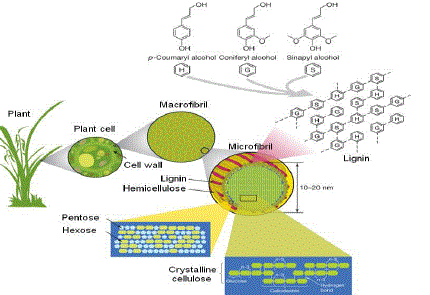 |
| Banana, Ankara and Pineapple fibres are projected as a good and quite promising source of natural fibre. These fibres can be extensively used in the manufacture of certain papers, particularly where high strength is required and also for decorative design items for the interiors of buildings. These fibres are complex in structure and are generally lignocellulosic consisting of helically wound cellulose microfibrils in amorphous matrix of lignin and hemicellulose. (Figure-1) |
BACKGROUND OF THE RESEARCH |
| A. Different types of lignocellulosic fibers can be used to make handmade papers / paper boards. Cotton rag / hosiery waste fibre are being currently used as the major source of fibre, but other sources can work just as well. Problems such as availability, collection, handling, storage, separation, and uniformity will need to be considered and solved. Some of these are technical problems whereas others are a matter of economics. Currently available sources of fibre can be blended with short fibre or used separately. For example, large quantities of banana fibre are available which can be used as the long fibres [2]. |
| B. The handmade paper industry with minimum effluent discharge and small size units allows a large canvas for mill location taking advantage of several options such as proximity to consumer or exporter centers, easy accessibility for transportation of supplies and products to various consumer centers, as well as a large employment potential. As the Indian economy is a rural economy, this production system will not only stop the wealth drain from rural to urban areas but also establish a strong industrial base for rural development. |
| C. These non-wood fibers have tremendous variations in chemical and physical properties. Of particular importance for pulping are fibre length, lignin content and cellulose content. Fiber length-Non wood fibers average 3 mm (banana) and can be as long as 9 mm (pine apple), (Table-1) [3]. Lignin content-Lignin content of fibers is lower than that of any woody pulp. The low lignin content indicates that these fibres will require very mild pulping conditions. |
| Cellulose content-Cellulose content of these fibers is 80% and higher, (Table-2) [3]. |
| D. Earlier pulping of this fibre done with different pulping methods where the effluent discharge was a problem for the industry people. Now the pulping by means of Alkaline Sulphite Process enables them to use this black liquor for other adhesive industries [4]. |
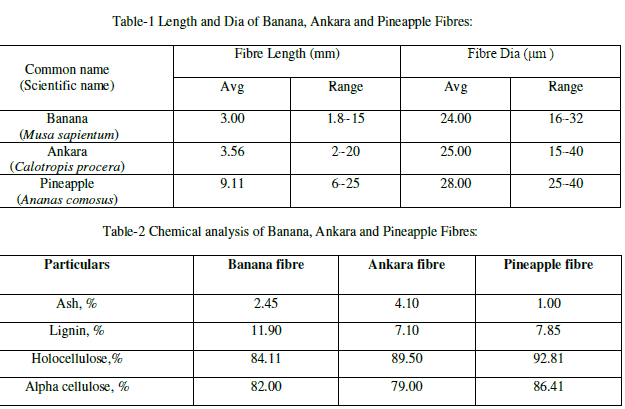 |
METHODOLOGY AND DISCUSSION |
| A. Alkaline Sulphite Pulping (ASP): |
| After cutting the raw materials into suitable size ie 1-1.5 inches, it was subjected to alkaline sulphite pulping (ASP) method. The raw materials were cooked at 120° C temperature with 8%, 10% and 12% of total chemical out of which 70% NaOH and 30% Na2SO3 were maintained for three hours with the bath ratio 1:8. The conditions are depicted in Table 3. [3]. |
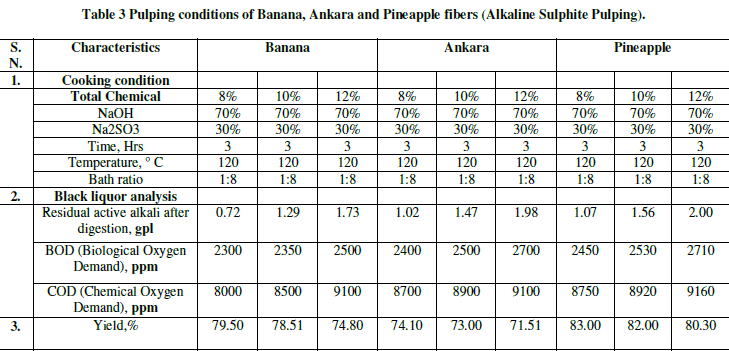 |
| Strength Characteristics: |
| After washing, the fibers were beaten in laboratory valley beater. The pulps were beaten up to ~300 ml CSF (Canadian Standard Freeness) and laboratory sheets of 60 GSM were formed in hand sheet former. The sheets were conditioned for 24 hours at 27+1ºC and 65+2 % relative humidity. After conditioning, the physical strength properties were evaluated as per the Standard Test Methods viz. TAPPI, BIS, IS & ISO: 2471. The results are recorded in Table 4 & Graph-1. [3] |
| B. Blending with hosiery waste at Pilot Plant level |
| B.1. Beating of Hosiery Pulp: The strength characteristics of a sheet of handmade paper / paper boards highly depend on its original qualities, types of fibres and on the extent of bonding between fibres that make up the sheet. The major effects of beating on fibre include (Clark, 1985): |
| External fibrillation- the outer layer of the fibre bonds are removed, exposing fibrils of the secondary wall. New external surfaces are created, which can participate in polyelectrolyte adsorption and inter-fiber bonding. |
| Internal fibrillation- Intra-fibre bonds are broken and the wall structure becomes more porous, enhancing water absorption, fibre swelling (hydration) and flexibility. The fibre wall swelling occurs inwards towards the lumen, with a corresponding decrease in lumen volume, while the other diameter of the fibre remains unchanged. |
| Fine formation- Pieces of fibre wall depth from the fibre, creating secondary fine. These can consist of exposed cellulose fibrils from the secondary wall, and material from the primary wall and middle lamella, in case of high yield pulps. |
| Release of the chemical components– Bast or leaf polymers and pulping chemicals may be released during the beating and may in themselves create a cationic demand in the pulp suspension. All four effects occur simultaneously, but to different extents depending on the control of the variable in the beating process. The shortening of fibres improves sheet formation considerably, thus contributing to paper uniformity and smoothness. However, fibre shortening causes a large reduction in tearing and folding resistance of the resulting paper, a proportional reduction in the bursting strength, and small reduction in tensile strength. The action of crushing the fibre against each other, or between metal surfaces organizes the bundles of cellulose fibrils, near the surface to become free [4]. |
| The newly exposed surfaces avidly interact with water molecules producing swelling and an increase in fibre surface. Both shortening and external fibrillation of the fibres produce free small fragments of cell wall called fines. Fines greatly reduce the drainage of water in paper formation by filling pores in the sheet, but provide at same time more fibre - fibre contact area. It is known that internal fibrillation separates bundles of fibrils located in the interior of cell wall of fibres without causing generation of fines. Water is then able to reach the new surfaces producing swelling and separating individual interior fibrils (hydration). As a result of the internal fibrillation, the fibre becomes plasticized and more deformable, improving fibre – fibre contact area when pressed and dewatered (Clark, 1985).Beating or refining of pulp is an essential process of paper manufacture and is carried out to a greater or lesser degree in all paper and board industry. On the other hand, some variables such as fibre properties, equipment characteristics and process variables affect refining process and final pulp and paper properties. |
| B.2. In order to create confidence among the entrepreneurs of Handmade paper industry, studies were upscaled to pilot scale (50 Kg capacity) using the Alkaline sulphite pulping for Banana, Ankara & Pineapple fibre as raw materials. Blending of the pulps produced from the Banana, Ankara & Pineapple was done in order to see the synergy of the three pulps with conventionally used hosiery waste to replace at level of 80% & 50% of the cotton hosiery pulp with 20% & 50% Banana, Ankara & Pineapple respectively. Results of blending with hosiery waste studies are shown in Table 5, 6 & 7 and Graph 2 & 3 respectively. |
| Use of spent liquor obtained from banana ASP cooked pulp |
| In order to find the suitability of black liquor generated from Alkaline Sulphite Pulping of raw material, an another experiment were conducted with the banana fibre alone. The cooking conditions are depicted in Table-8. Here only total 4% of chemicals were used. It has been possible to utilize the whole sulphite spent liquor as a source of industrially useful byproducts as lignin present in the raw materials get converted in to the lignosulphonates during sulphite process. The lignosulphonates thus produced after concentration to a solids content of 30%w/w were evaluated to explore its application as plasticizer and water reducing agents in concrete admixture to improve behaviors of fresh and harden concrete. |
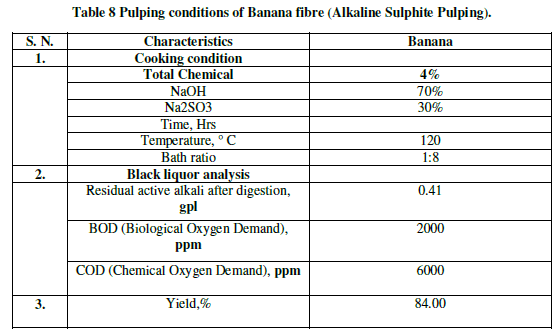 |
| In order to evaluate the application of lignosulphonates in cement the hydration behavior of ordinary portland cement (OPC) in presence of chemical admixtures with the sample of lignosulphonates obtained from the banana sulphite process (4% cooked ASP pulp liquor) was studied. The tests were conducted as an admixture on cement mortar for water consistency, setting time and compressive strength for 3 days,7 days and 28 days. The results of the action of lignosulphonates from banana sulphite liquor and its comparison with a commercial sample of lignosulphonates procured from the market as plasticizer during the hydration of OPC cement are shown in table 9. |
| From the results shown in table 9, it could be observed that the lignosulphonates obtained from the spent sulphite liquor obtained from sulphite pulping of banana fibre was found to perform satisfactorily as retardant in mortar/concrete admixture with significant improvement in the compressive strength. |
| The approach thus adopted for the utilization of the spent sulphite liquor as plasticizer should help in achieving zero black liquor discharge from the pulping of banana fibre thereby addressing the problem of environmental pollution besides helping to improve the economics of the process through sale of the waste product as industrially useful byproduct. [5]. |
EXPERIMENTAL RESULTS |
 |
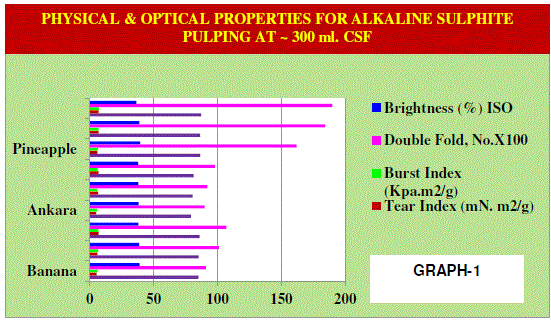 |
Results & Discussion: |
| From the result shown in table - 4 it has been observed that the strength properties are good enough to make any kind of handmade paper and paper boards. Again in some of the properties pineapple fibre showed better results than the other fibres at low chemical dosages particularly in case of tensile and burst strength. |
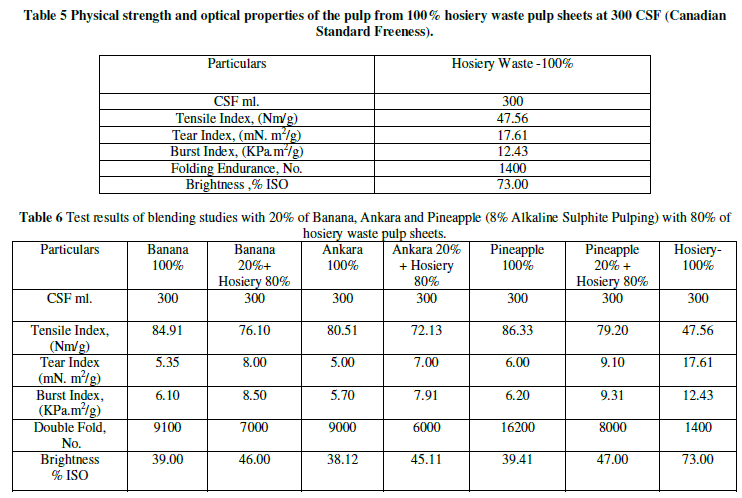 |
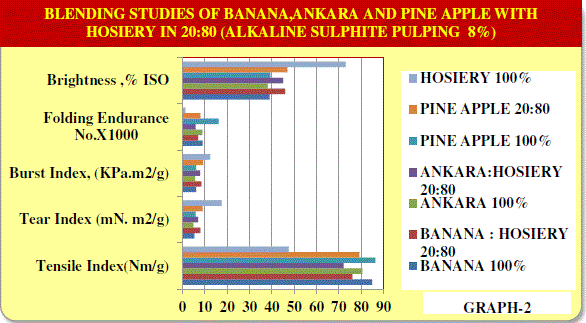 |
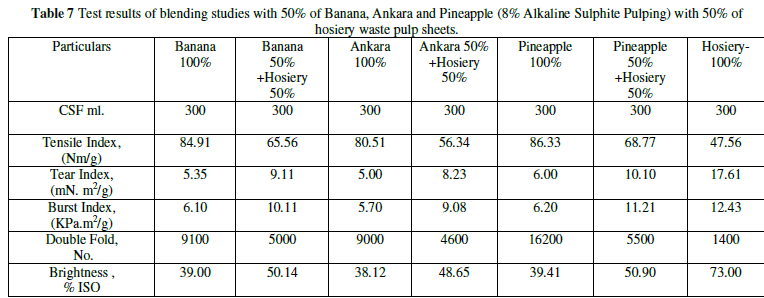 |
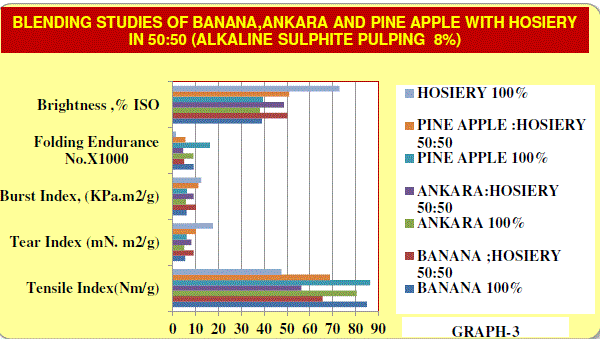 |
| From the results, it is clearly evident that the Tensile strength & Double folds were increased remarkably in both the cases. More than 5 times increase in double fold was one of the very good & important indications of exploring these fibres for high end products like currency paper & security paper etc. However, the conditions for pulping & bleaching may optimized further for its utilization in high end products. |
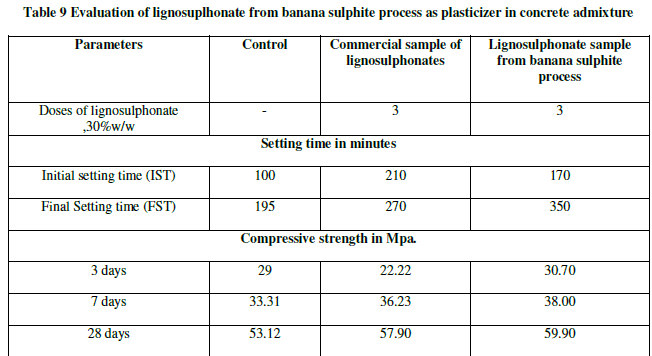 |
CONCLUSIONS |
| Lignocellulosic raw materials banana, ankara and pineapple may be used to produce a wide range of products ranging from very inexpensive, low performance paper / paper board to expensive, high performance paper / paper board. The wide distribution, renewability, and recyclability of these lignocellulosic raw materials can expand the market for lowcost paper / paper products. The pulping technology thus used, can be well suited to handmade paper makers to manufacture variety of paper / paper boards. |
| Paper products having complex shapes can also be produced using flexible fibre pulp. Within certain limits, any size, shape, thickness, and density is possible. These lignocellulosic fibres can be used to make handmade papers / paper boards by adopting Alkaline Sulphite Pulping Process. |
| The handmade paper industry with minimum effluent discharge and small size units allows a large canvas for mill location taking advantage of several options such as proximity to consumer or exporter centers, easy accessibility for transportation of supplies and products to various consumer centers, as well as a large employment potential. As the Indian economy is a rural economy, this production system will not only stop the wealth drain from rural to urban areas but also establish a strong industrial base for rural development. |
| These non-wood fibers have tremendous variations in chemical and physical properties. Of particular importance for pulping are fibre length, lignin content and cellulose content. These variations can be controlled by a systematic plantation. |
| The blending studies were made from banana, ankara and pineapple fibre pulp with hosiery waste in different proportions clearly indicates that the tensile index and folding endurance increases from 47.56 & 1400 to 76.10 & 7000, 72.13 & 600 and 79.20 & 7000 respectively in case of 80:20 ratio. While in case of 50:50 it is 65.56 & 5000, 56.34 & 4600 and 68.77 & 5500 remarkably which enable theses fibres for the use in currency notes and security paper. Though the tear and burst index goes to some lower side which can be compromised. Indian currency note is being made from cotton pulp so these blended pulp can be used for making security and currency paper where more tensile and folding is required. |
| The lignosulphonate obtained after the cooking of banana fibre with 4% ASP process were evaluated for it’s strength characteristics for suitability in adhesive and concrete industry. The results depicted in table – 9 tells about it’s suitability as setting time and strength is higher as compared to commercial one. Thus these fibres alone can be pulped with ASP method and with blending with some other fibre can find a suitable place not only in handmade paper industries but also in big paper industries. |
References |
|